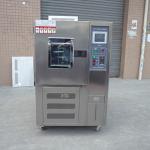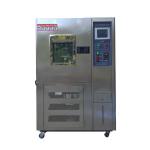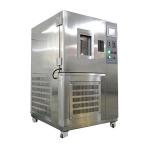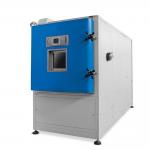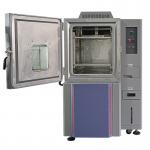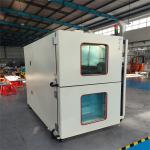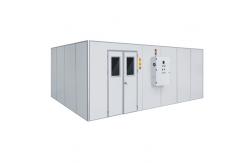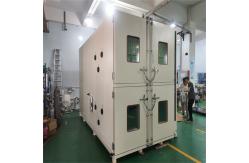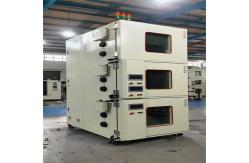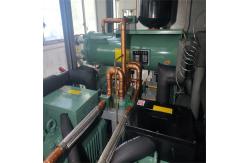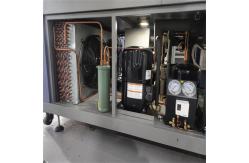In the aerospace industry, where safety and reliability are
non-negotiable, the performance of components and systems over time
is of utmost importance. The Customized Accelerated Aging Chamber
for Aerospace Industry is a state-of-the-art solution that allows
for the simulation of extreme conditions and the passage of time,
enabling manufacturers and engineers to assess the long-term
durability and integrity of aerospace equipment. This specialized chamber is designed to subject aerospace
materials, components, and subsystems to a comprehensive range of
accelerated aging factors. It serves aerospace manufacturers,
research institutions, and regulatory bodies. The primary objective
is to predict how these elements will behave and degrade over their
expected service lifetimes in a fraction of the actual time. By
doing so, potential failures can be identified and mitigated,
ensuring the highest levels of safety and performance in aerospace
applications. - Robust and High-Performance Construction
- The chamber is fabricated from a high-strength alloy framework,
capable of withstanding the intense mechanical and thermal stresses
generated during testing. The exterior is protected by a
corrosion-resistant and heat-resistant coating, suitable for the
harsh environments associated with aerospace testing. The interior
is lined with a thermal and chemical barrier material, ensuring
that the tested samples are not affected by the chamber itself. The
door is a heavy-duty component, featuring a multi-point locking
system and a high-temperature sealing gasket, maintaining a
hermetic seal even at extreme temperatures and pressures. A small,
reinforced viewing window, made of a special glass or ceramic
material, allows for visual inspection without compromising the
integrity of the test environment.
- Precision Environmental Control Systems
- Temperature Control: Capable of reaching temperatures from -100°C
to +300°C, with an accuracy of ±1°C. It utilizes advanced cryogenic
cooling and high-power resistive heating technologies, integrated
with a highly precise PID (Proportional-Integral-Derivative)
control algorithm. Multiple thermocouples are strategically placed
throughout the chamber to ensure uniform temperature distribution.
The user-friendly control panel allows for the programming of
complex temperature profiles, including rapid temperature ramps,
extended soak times at specific temperatures, and cyclic
temperature sequences. For example, it can simulate the temperature
changes that a component might experience during a flight from the
cold stratosphere to the hot conditions near the engine or during a
re-entry into the Earth's atmosphere.
- Humidity Control: The humidity control system can maintain relative
humidity levels from 0% to 100% RH, with an accuracy of ±3% RH. It
employs a combination of steam injection humidifiers and desiccant
dehumidifiers, synchronized with a laminar flow air circulation
system. The chamber is equipped with highly accurate capacitive
humidity sensors that continuously monitor the internal humidity,
and the control system makes real-time adjustments. This is crucial
for testing the effects of moisture on aerospace components, such
as the corrosion of metal parts or the degradation of composite
materials in humid conditions. The system can also be programmed to
create rapid humidity changes, similar to what might occur when an
aircraft transitions between different altitudes or environments.
- Pressure Control: The chamber can precisely control pressure
levels, from near-vacuum conditions (equivalent to high-altitude
flight) to several times atmospheric pressure. The pressure control
system has an accuracy of ±0.05 kPa and can rapidly adjust the
pressure to simulate the rapid depressurization during a cabin leak
or the pressurization changes during ascent and descent. This is
vital for evaluating the impact of pressure on aerospace equipment,
such as the integrity of seals, the performance of
pressure-sensitive components, and the outgassing of materials.
- Radiation Simulation: To mimic the radiation exposure that
aerospace components will face in space or at high altitudes, the
chamber is equipped with a radiation source that can generate a
variety of ionizing radiations, including gamma rays and protons.
The radiation intensity and exposure time can be precisely
controlled, allowing for the assessment of the radiation-induced
degradation of materials and components. This is a unique feature
that is essential for understanding the long-term durability of
aerospace products in the highly radioactive environment of space
and upper atmosphere.
- Advanced Instrumentation and Data Acquisition
- The chamber is outfitted with a comprehensive suite of sensors and
instrumentation. In addition to temperature, humidity, pressure,
and radiation sensors, it includes sensors for measuring other
parameters such as strain (to monitor the deformation of components
under stress), vibration (to simulate the mechanical vibrations
during flight), and gas composition (for testing the effects of
different atmospheres). These sensors are connected to a
state-of-the-art data acquisition system that records and stores
all relevant data. The data acquisition system offers a high
sampling rate, typically ranging from 1000 to 5000 samples per
second, ensuring that even the most rapid and minute changes in
environmental conditions or component properties are accurately
captured. The collected data can be accessed and analyzed in
real-time or retrieved later for in-depth studies. The system is
also compatible with aerospace data analysis software, enabling the
generation of detailed reports and graphical representations of the
test results, which are crucial for making informed decisions about
component design, material selection, and maintenance schedules.
- Enhanced Safety and Compliance Features
- The Customized Accelerated Aging Chamber for Aerospace Industry is
designed with multiple layers of safety features. It incorporates
an automatic emergency shutdown system that activates immediately
in the event of any critical malfunction, such as overheating,
overcooling, excessive pressure, or a radiation leak. The chamber
is equipped with a fire suppression system, which can quickly
extinguish any potential fires that may occur due to electrical
faults or component failures. The ventilation system is engineered
to remove any harmful gases or fumes that may be generated during
testing, protecting both the samples and the operators. The control
panel is designed with safety interlocks and clear warning
indicators to prevent accidental operation and ensure the
well-being of personnel. Additionally, the chamber complies with
all relevant aerospace industry standards and regulations,
including those set by NASA (National Aeronautics and Space
Administration), ESA (European Space Agency), and FAA (Federal
Aviation Administration), ensuring that the testing procedures are
recognized and accepted by regulatory bodies and industry peers.
- Chamber Size and Capacity: Available in different sizes to accommodate various sample sizes
and quantiti
|
